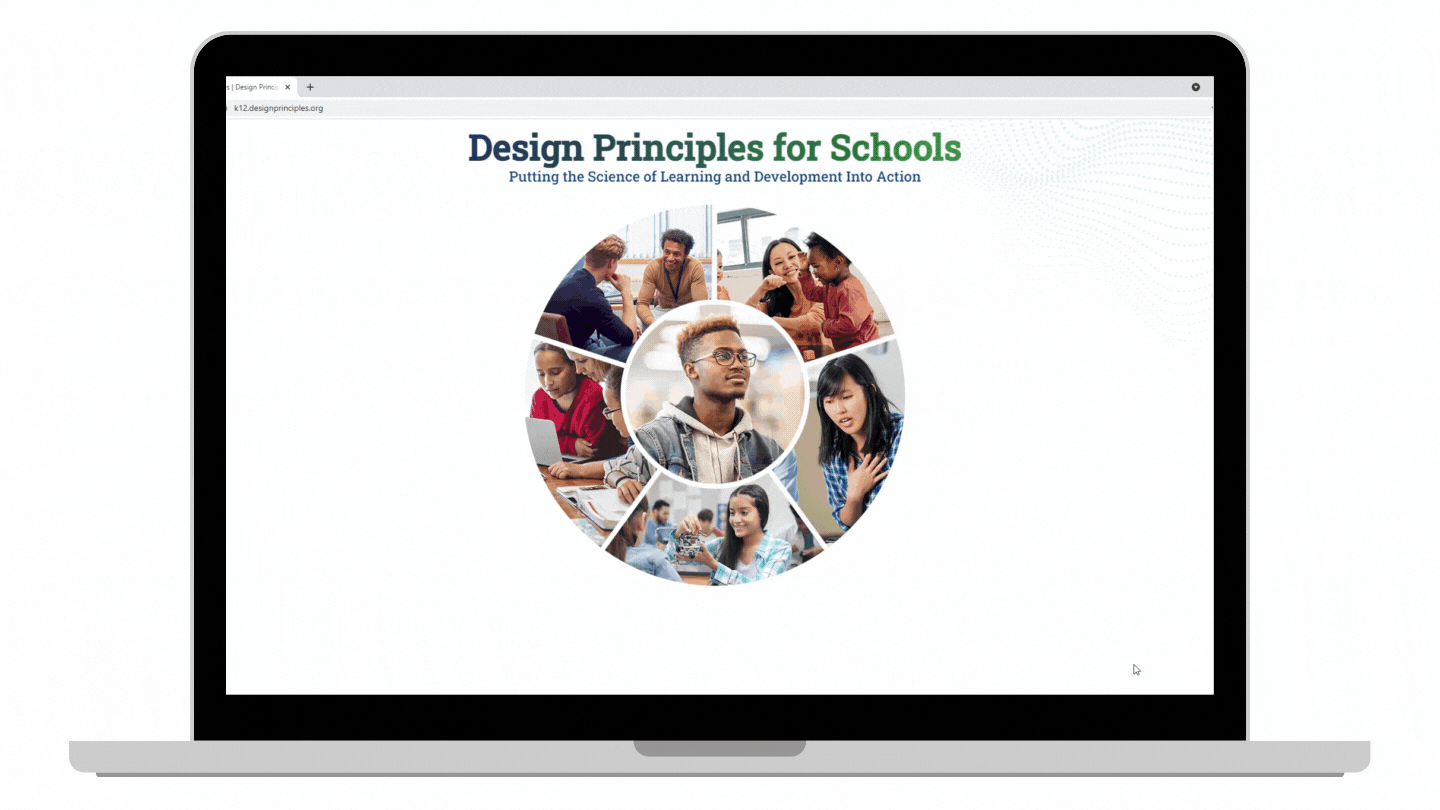Design Principles
How can we design equitable learning settings so that all young people can thrive?
The Design Principles is a collaborative project led by the Forum for Youth Investment, Learning Policy Institute, and Turnaround for Children, in association with the Science of Learning and Development Alliance and 100+ leaders from across the fields of education and youth development. The project represents a collective commitment to equitable outcomes for every child and a collective understanding of how to create the conditions that enable those outcomes.
The Design Principles project synthesized what is known from the science into key elements that need to be present and integrated in order to optimize learning and development: the Essential Guiding Principles for Equitable Whole-Child Design. Building from the science of learning and development, each of the five elements of the wheel is grounded in a substantial body of research from diverse fields. Taken together, they are the key ingredients to healthy development, learning, and thriving:
- Positive developmental relationships
- Environments filled with safety and belonging
- Rich learning experiences and knowledge development
- Development of skills, habits and mindsets.
- Integrated support systems
These five elements must be integrated and implemented in ways that are personalized, empowering, culturally-affirming and transformative.
The Design Principles are useful for any setting in which young people learn and develop, including schools and community settings. They are valuable for designing new learning settings, assessing existing settings, and exposing and upending inequities across the learning and development ecosystem, from classrooms to extra-curriculars to community-based programming, at every level of decision-making—from classrooms to systems to policies.
The Design Principles provide the scientific foundation for the principles of whole-child design and ways to apply them: outlining the features of a learning setting designed for the whole-child; demonstrating their significance; and sharing evidence-based practices to bring them about.
The Design Principles project created two Playbooks, one for K-12 and one for community settings, that provide detailed descriptions of and support for structures and practices that characterize whole-child design. The Playbooks include case studies and resources designed by practitioners, scientists and community stakeholders, including parents; they also include tools from the Turnaround for Children Toolbox. The Design Principles will enable educators, leaders, and policymakers across the field to anchor their own programs, frameworks, projects, products, and resources to a shared set of guiding principles. Turnaround’s Whole-Child Design Blueprint is one example of how to do that.
How can educators operationalize the Design Principles in schools?
Turnaround’s Blueprint makes whole-child design simple, accessible and actionable.
The Essential Guiding Principles for Equitable Whole-Child Design are the inspiration and scientific foundation of the Whole-Child Design Blueprint, Turnaround’s operationalization of the Design Principles. The Whole-Child Design Blueprint is an actionable framework—matched with a set of tools—that enables educators to look through the lens of whole-child development and take action toward creating the conditions for equitable whole-child learning and development in their own classrooms, schools and systems; there are also applications for settings outside of school. It reinforces and translates the Design Principles into concrete systems, structures and practices for educators, pairing them with concrete tools and guidance for implementation. The Blueprint integrates the Essential Guiding Principles to meet educators’ current needs and acknowledges the importance of starting with a whole-child purpose and sharing leadership and ownership to ensure that the change process is equitable.
Key components include:
- Start with a shared purpose and commitment to holistic development and equitable outcomes for all students that drives improvement goals and priorities
- Co-create a supportive school and classroom environment that is physically, emotionally, and identity safe, while creating a strong sense of community and belonging.
- Shift to developmental relationships – among teachers, students, leaders, and community – as the foundation.
- Set students up for success by facilitating rich learning experiences that integrate knowledge, skill and mindset development.
- Engage in transformational change together through shared leadership and ownership.
The Whole-Child Design Blueprint reflects the complex and relational nature of how young people develop. The framework’s components and core practices are a way to think about, organize and integrate the non-negotiables for settings created with the science of learning and development in mind. The Blueprint enables educators to understand how to bring about the conditions identified through the Design Principles project, offering a set of integrated, mutually-reinforcing insights that, once internalized, create a new mental model to guide practice. The application of this science-grounded, equity-driven framework can and should be unique and personalized for every school, taking into account its own assets and needs.
The Turnaround for Children Toolbox is centered on the Whole-Child Design Blueprint and grounded in the same science as the Design Principles.
Create a supportive environment, cultivate developmental relationships, and build students’ knowledge, skills, and mindsets—all centered around a whole-child purpose.
The Turnaround for Children Toolbox is an online hub for tools, resources and guidance that deepens knowledge of whole-child design and empowers educators to start this work in their own schools and systems.
The resources in the Toolbox are centered on Turnaround’s Whole-Child Design Blueprint and grounded in the same scientific research as the Design Principles. The Toolbox includes assessments and measurement tools, planning guides, videos, articles, and more. With these tools, educators can collaborate with colleagues, students, and community members to both design for and measure healthy development, learning, and thriving in their own settings.
The Toolbox includes resources to immediately apply the Design Principles to educators’ historic work, the challenges of the current moment, and their long-term change agenda. Tools from the Turnaround Toolbox are included in the Design Principles Playbooks. Turnaround offers capacity-building experiences to educators that align with and build upon the resources and insights within the Toolbox and Blueprint.


Share